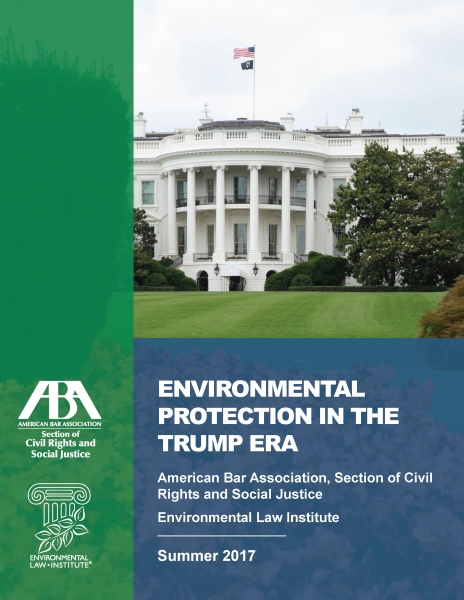Here at ELI, we’ve seen a growing demand for unbiased answers and analysis on how deregulatory initiatives by the Administration and Congress will impact environmental protection, governance, and the rule of law. To that end, we recently collaborated with the American Bar Association’s Civil Rights and Social Justice Section to publish an ebook to aid understanding of the legal mechanisms that the White House, federal agencies, and Congress are using to change the regulatory approach to environmental, natural resources, and health and safety protections. The book attempts to answer these questions: What are the pathways and potential impacts of these ongoing regulatory changes? What are the opportunities for the public and other stakeholders to engage relative to these initiatives?
 |
Available as a free download, Environmental Protection in the Trump Era serves as a resource for lawyers, policymakers, academics, journalists, and students of environmental law and policy. Authored by ELI Senior Attorneys Jay Austin, Tobie Bernstein, and Jim McElfish, Visiting Attorney Scott Badenoch, and Public Interest Law Fellow Ben Solomon-Schwartz, the book provides a snapshot of major Trump Administration and Congressional actions on climate change, clean air and water, pipelines and offshore drilling, toxic properties and Superfund sites, regulatory rollbacks, agency budget and personnel cuts, and environmental justice.
The first edition focuses on the more immediate changes we have seen (and actions we might expect to see), including lesser-known or more arcane legal mechanisms that have the potential to effect long-term change in environmental protection.
While the book does not seek to prioritize issues, some overarching themes emerge. Notably, in light of changes in the federal approach, the role of the states has already become more prominent in relation to climate change, environmental health, and other issues. State legislators and agency officials will play an increasingly important role in developing their own durable policies and programs, and responding to any federal attempts to preempt state regulation. And citizen action may emerge as an even more important part of the accountability system if the federal government’s role in environmental protection is reduced.
The book’s topics include:
- How Executive Actions Can Shape Environmental Law
- What the “Two-for-One” Executive Order on Regulation Means for Environmental Law
- How Congress Can Override Environmental Regulation
- “Fast-Tracking” Pipelines, the Border Wall, and Other Infrastructure Projects
- Reviewing, Revising, or Revoking Protection of National Monuments
- Increasing Offshore Drilling for Oil and Gas
- Withdrawing from the Paris Agreement on Climate Change
- Reversing or Weakening Existing Environmental Regulations
- Cutting Enforcement of Environmental Law
- Cutting Funding for Environmental Protection
- Preventing States From Enacting and Enforcing Their Own Laws
- Creating New Roadblocks for Future Regulation
- Weakening Protections Affecting Environmental Justice
This edition is available to download in full or by individual chapter at: https://www.eli.org/eli-press-books/environmental-protection-trump-era. And stay tuned for a second edition, expected in early 2018.
